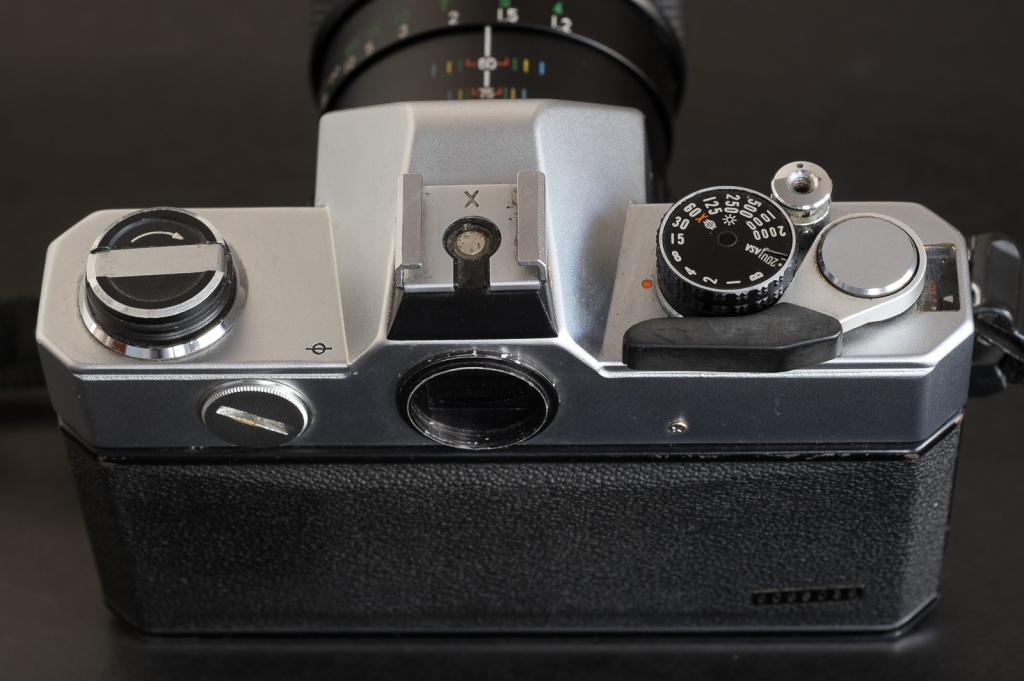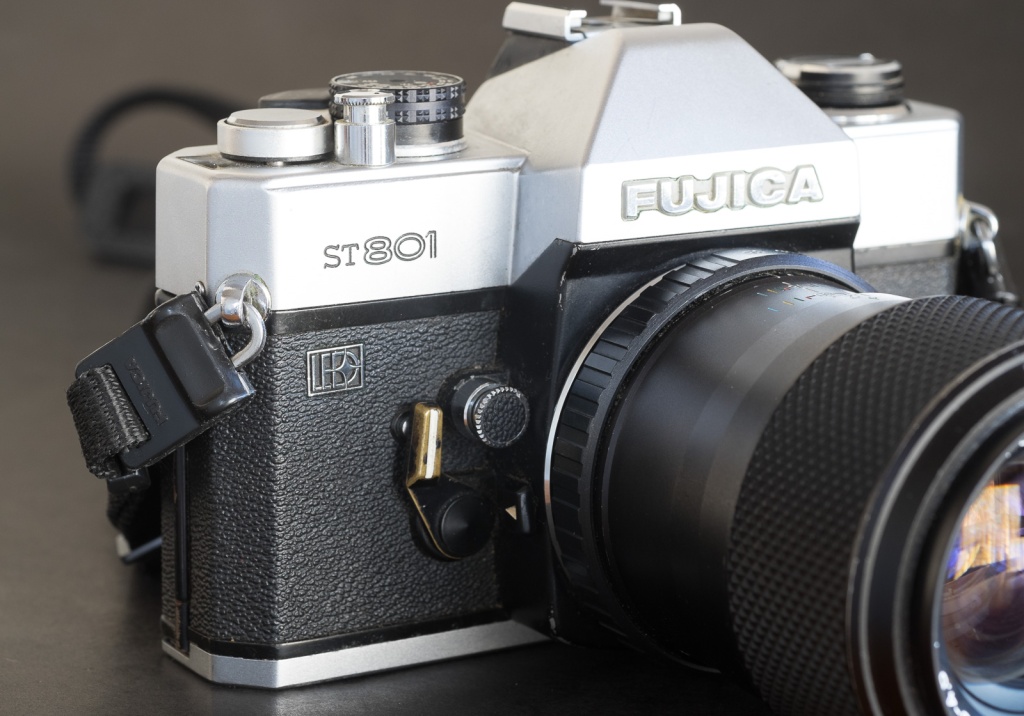A simple semi-auto 35mm SLR, the Fuji STX-2 is a typical learner’s camera. It is better at this exercise than the over simplified and somehow antique Pentax K1000, although it does not benefit from the huge supply of Pentax K compatible lenses on the second hand market: it uses Fujica’s proprietary X-mount bayonet.
Over the course of the last 18 months, I’ve purchased and tested half a dozen Fujica and Fuji SLRs from the seventies and early eighties.
Some I really liked – the ST801 (1972) is one of the very best m42 (universal screw mount) semi-auto cameras ever built. The AX-3 of 1979 is a very competent aperture-priority camera designed for enthusiast amateurs. Some I did not particularly like – the AZ-1 of 1978, an automatic camera deprived of a semi-auto override and of the digital numeric display of the ST901- or the AX-5, too close to its entry-level siblings in spite of its impressive specs sheet. The worst of the Fuji 35mm SLRs was also the last one, the AX-Multi Program of 1985, with very limited capabilities and a questionable build quality.

When Fuji launched their X-mount bayonet mount in 1979, they presented three new models all based on the same new chassis (the program mode only AX-1, the AX-3 and the top of the line AX-5), as well as an entry level semi-auto camera, the STX-1. The first two letters of its name were telling the whole story: it was a close derivative of the ST series, where the m42 lens mount had simply been replaced with the new Fujica X-mount bayonet. In 1982, its matching needle meter was replaced with 3 LEDs, and it became the STX-1n. In 1985, in parallel to the AX Multi, Fuji also launched an updated version of the semi-auto STX-1n, the STX-2. High level, it is a plastic bodied version of the STX-1n, with a shutter upgraded to go up to 1/1000 sec.

The good
Contrarily to the AX Multi, the STX-2 is not an over-simplified camera. It’s a true semi-auto camera, with a depth of field preview, a split image telemeter, a big needle showing the pre selected shutter speed in the viewfinder, and a mechanical timer for…selfies, all features that the prototypical learners’ camera, the Pentax K1000, is missing. Its metering system is based on a silicon cell, which controls a set of 3 LEDs at the right of the viewfinder. TTL (Through The Lens) metering not only works with the Fujica’s X-Fujinon lenses, but also, thanks to an adapter, with almost any m42 screw mount lens (stopped down).

The average weighted metering system seems reasonably accurate, and only requires two very common LR-44 batteries (alcaline) or SR-44 (silver oxide).

It can not be equipped with a winder, does not show the pre-selected aperture in the viewfinder, but on an entry level camera it’s not a big issue.
The bad
The biggest disappointment is the viewfinder. It’s narrow, dark, and lacks contrast. It is significantly worse than the viewfinder of the AX-3 and AX-5 cameras (which is somehow OK without being great), and horribly worse than the viewfinder of their common ancestor the ST801, which is at the same time wider, brighter and more precise.

The other issue, of course, is the scarcity of X-Fujinon lenses on the market place. The Fujica STX and AX cameras came generally bundled with one of the multiple variants of a 50mm f/1.9 standard lens, which are still abundant today, but very few photographers bothered to buy anything else. Those who did mainly purchased the 43-75mm zoom or the 135mm tele, with the 28mm wide-angle lens finding a few takers. Other lenses (while nominally on Fuji Photo Film’s large catalog of lenses) were probably never stocked by retailers, and are nowhere to be seen today. And the situation is not really better with the independent optical companies: with the exception of Tamron (which had an Adaptall 2 ring for the Fujica X mount), none of the big brands seem to have made lenses for Fuji’s bayonet.
The ugly
The STX-2 does not look as bad as the AX-Multi, but only by a small margin. The fit is correct (no gap between parts, no loose part) but the finish disappoints: black plastics body is dull and easily scratched, and the dials and knobs leave an unmistakable feeling of cheapness.

As a conclusion
Because it’s a simple mechanical camera closely derived from a long line of m42 screw mount semi-auto SLRs (from the ST701 to the ST605), the STX-2 does not seem to have suffered from the reliability issues of the AX series. It has not been spec’d down to give a false impression of simplicity like the AX-1 or the Multi-AX, and on paper, it has everything a beginner eager to learn the basics of photography will need. Because it’s mainly built out of plastics, it’s also a very light camera (510g), and you will forget it’s in your backpack when you’re hiking. With an adapter, it can use almost any m42 screw mount lens (Fujinon or other) in addition to the difficult to find X-Fujinon lenses.

That being said, it’s also an ugly camera with a bad viewfinder. If I had a large collection of m42 screw mount lenses, I would rather use them with a nice Fujica ST801. The 801’s shutter is faster (1/2000 sec, which is sometimes useful now that 400 ISO is the new normal film sensitivity) and its viewfinder much more comfortable to use.
If I had a few really good X-Fujinon lenses (there is a 50mm F/1.2 EBC I’d like to find one day), mounting them on an Fujica AX-3 would make more sense to me: it’s a fully featured aperture priority camera, with a good semi-auto mode, a decent viewfinder and a nice finish. I would simply bring along a STX-2 as a backup, in case the electronics of the AX-3 decides to go on strike.
If you look at the prices on eBay, the STX-2 is almost the most expensive of the Fujica and Fuji bayonet SLRs: only the rare top of the line AX-5 will cost you more. I can understand why it could be worth more than other Fujica and Fuji AX cameras: it’s the best spec’d of the mechanical semi-auto cameras, and it’s simpler and probably more reliable than its siblings of the AX series. But if I was on the market for a learner’s camera, I would also consider cameras such as the Nikon FM or the Olympus OM-2000: they may be slightly more expensive, but the FM is more solidly built, the OM-2000 has a faster shutter, and both have a better viewfinder and a much wider choice of lenses on the second-hand market. Not to mention that they also look much nicer.
In my opinion, unless you’re a passionate collector of all things Fuji, buying a STX-2 only makes sense if you can get it for real cheap (a few US dollars), or with one or two lenses to sweeten the deal.
Brand salad:
- the ST, STX and AX 35mm SLR cameras were manufactured in Japan by Fuji Photo Film, and sold under the Fujica brand until 1985, when they were simply rebranded as Fuji. The company is still in business today, and operates under the Fujifilm name. The lenses were sold as Fujinon (m42 mount), X-Fujinon and X-Fujinar (X- mount). Fuji also had lenses branded as X-Kominar in their catalog (from Komine, an independent optics company also working for Vivitar).
- Fuji film’s current bayonet is also named the X-mount, their current lenses are named Fujinon-XC or XF, but there is absolutely no compatibility between the old and the new generation.
- Fuji was (and still is very) proud of its lens treatment process, and the lenses that benefit from it are recognized as Fujinon EBC lenses.
- Fuji also sold its camera and lenses in Germany and Central Europe through the Porst retail network. I don’t think that the STX-2 was every sold by Porst, but the STX-1 was sold as the Porst CR-1, and Fuji’s lenses as Porst UMC X-F lenses.
- Today, Fujifilm is known for its digital cameras (APS-C and medium format mirrorless systems), and still makes serious money in the film business, with its instant film and cameras (Instax). The majority of the revenues of the company come from their document printing equipment business, and to a lesser extent, from their activities in the chemical and cosmetic industries.





 Fujica AZ-1 and Fujinon-X f/3.5-4.5 43mm-75mm zoom – the AZ-1 was the first mass market SLR bundled with a zoom instead of the standard 50mm lens.
Fujica AZ-1 and Fujinon-X f/3.5-4.5 43mm-75mm zoom – the AZ-1 was the first mass market SLR bundled with a zoom instead of the standard 50mm lens.


